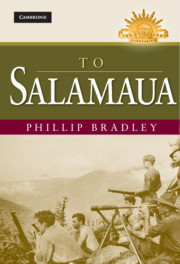Book contents
- Frontmatter
- Contents
- Foreword
- List of illustrations
- Acknowledgements
- Abbreviations
- Introduction
- 1 Death in the Bismarck Sea
- 2 Opposing forces
- 3 Warfe's tigers
- 4 Supply lines
- 5 Mubo stalemate
- 6 On Lababia Ridge
- 7 On Bobdubi Ridge
- 8 Yanks
- 9 Mubo falls
- 10 ‘A bit of a stoush’
- 11 The forbidden mountain
- 12 Roosevelt Ridge
- 13 Old Vickers
- 14 Komiatum Ridge
- 15 Across the Frisco
- 16 Salamaua falls
- Appendix: Place names
- Notes
- Bibliography
- Index
1 - Death in the Bismarck Sea
Published online by Cambridge University Press: 05 December 2013
- Frontmatter
- Contents
- Foreword
- List of illustrations
- Acknowledgements
- Abbreviations
- Introduction
- 1 Death in the Bismarck Sea
- 2 Opposing forces
- 3 Warfe's tigers
- 4 Supply lines
- 5 Mubo stalemate
- 6 On Lababia Ridge
- 7 On Bobdubi Ridge
- 8 Yanks
- 9 Mubo falls
- 10 ‘A bit of a stoush’
- 11 The forbidden mountain
- 12 Roosevelt Ridge
- 13 Old Vickers
- 14 Komiatum Ridge
- 15 Across the Frisco
- 16 Salamaua falls
- Appendix: Place names
- Notes
- Bibliography
- Index
Summary
The glassy blue surface of the Bismarck Sea shimmered beneath a cloudless sky, the morning mist gone ‘as though wiped away’ by the sun. Major-General Kane Yoshihara, the Chief of Staff of the Japanese Eighteenth Army, was aboard the destroyer Tokitsukaze, part of a fifteen-vessel convoy afloat on the Bismarck Sea, headed for Lae. Although Tokitsukaze translated as ‘favourable wind’, the weather would do the Japanese convoy no favours on this morning. Yoshihara was below deck discussing debarkation procedures with the troops when disaster struck from the sky. The destroyer then stopped dead in the water, ‘as though the ship had struck a rock’. By the time he reached the deck, a bewildered Yoshi-hara could see that only half the convoy vessels were left afloat and, like the Tokitsukaze, smoke billowed skywards from most of them, signifying their fate.
By the end of February 1943 World War II was at a turning point. In the European theatre the German army on the eastern front had been decisively defeated at Stalingrad and was in retreat, desperately trying to hold back the Soviet tide. In North Africa it was a similar story for the German army as the British and American armies approached Tunisia. In the Atlantic Ocean the crucial battle for control of the convoy routes over the marauding U-boats was approaching its climax while in the skies above Western Europe Allied air power was remorselessly gaining the upper hand.
- Type
- Chapter
- Information
- To Salamaua , pp. 3 - 30Publisher: Cambridge University PressPrint publication year: 2010



